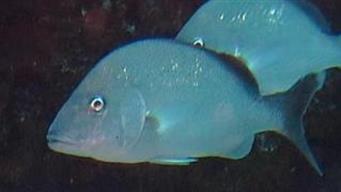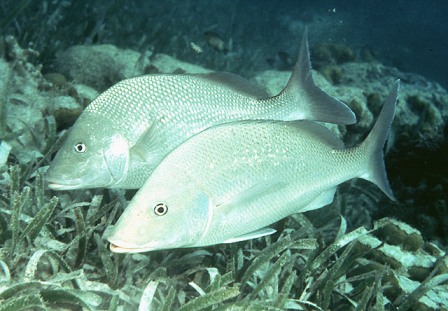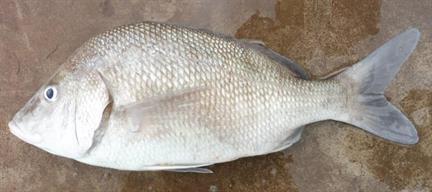



Haemulon album
| Ecological Descriptors |
||||
| Habitat | Size (cm) | Diet | Behaviour | Sex |
| Co, R, S (Man) | 79 | Cru, Mol, Pisc, Wor, Ech | P, Sh | F |
Description:
Usual color phase dull silvery, but can be pale olive-green. Humped back. Has dark grey second dorsal and caudal fins. Other fins clear/ pale, with pelvic fins having white first ray. No black pigment below upper margin of preopercle. Small eye with white iris.
Ecology
A reef-associated species that occurs at depths of 2 to 60m (5-220ft). It is associated with clear water around coral reefs, rocky bottoms, wreck sites and seagrass beds. Individuals are usually found in pairs or larger schools. Juveniles are generally found in shallow water habitats, including seagrass and occasionally mangroves. Older life stages occur in deeper reef habitats. Density of this species is higher on shallow reefs, but its size was greater on deeper reefs. This species schools during the day and disperses in late afternoon to feed. Common food organisms include bivalve molluscs, crustaceans and small fishes, as well as benthic invertebrates as peanut worms (Sipuncula) and heart urchins (Spatangoida).
Life Cycle:
Minimum size of maturation for females and males is 30-32 cm and 26-28 cm , respectively. The age of maturation for females is three to four years. This species is a continuous, asynchronous, multibatch spawner, with primary months being April to June. Pelagic eggs and larvae.
Usual color phase dull silvery, but can be pale olive-green. Humped back. Has dark grey second dorsal and caudal fins. Other fins clear/ pale, with pelvic fins having white first ray. No black pigment below upper margin of preopercle. Small eye with white iris.
Ecology
A reef-associated species that occurs at depths of 2 to 60m (5-220ft). It is associated with clear water around coral reefs, rocky bottoms, wreck sites and seagrass beds. Individuals are usually found in pairs or larger schools. Juveniles are generally found in shallow water habitats, including seagrass and occasionally mangroves. Older life stages occur in deeper reef habitats. Density of this species is higher on shallow reefs, but its size was greater on deeper reefs. This species schools during the day and disperses in late afternoon to feed. Common food organisms include bivalve molluscs, crustaceans and small fishes, as well as benthic invertebrates as peanut worms (Sipuncula) and heart urchins (Spatangoida).
Life Cycle:
Minimum size of maturation for females and males is 30-32 cm and 26-28 cm , respectively. The age of maturation for females is three to four years. This species is a continuous, asynchronous, multibatch spawner, with primary months being April to June. Pelagic eggs and larvae.
White Margate


White Margate
(C) JE Randall



43


329
White Margate

